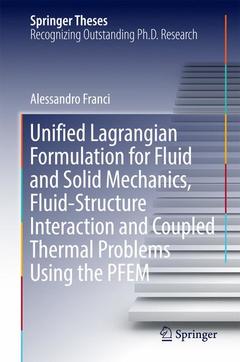Description
Unified Lagrangian Formulation for Fluid and Solid Mechanics, Fluid-Structure Interaction and Coupled Thermal Problems Using the PFEM, Softcover reprint of the original 1st ed. 2017
Springer Theses Series
Author: Franci Alessandro
Language: English
Subject for Unified Lagrangian Formulation for Fluid and Solid...:
Publication date: 10-2016
Support: Print on demand
Publication date: 06-2018
Support: Print on demand
Description
/li>Contents
/li>Comment
/li>
This book treats the derivation and implementation of a unified particle finite element formulation for the solution of fluid and solid mechanics, Fluid-Structure Interaction (FSI) and coupled thermal problems.
FSI problems are involved in many engineering branches, from aeronautics to civil and biomedical engineering. The numerical method proposed in this book has been designed to deal with a large part of these. In particular, it is capable of simulating accurately free-surface fluids interacting with structures that may undergo large displacements, suffer from thermo-plastic deformations and even melt. The method accuracy has been successfully verified in several numerical examples. The thesis also contains the application of the proposed numerical strategy for the simulation of a real industrial problem.
This thesis, defended at the Universitat Politecnica de Catalunya in 2015, was selected (ex aequo) as the best PhD thesis in numerical methods in Spain for the year 2015 by the Spanish Society of Numerical Methods in Engineering (SEMNI).Nominated as an outstanding PhD thesis by the Spanish Society of Numerical Methods in Engineering, Sociedad Española de Métodos Númericos en Ingeniería (SEMNI)
Formulates versatile finite element for FSI problems
Includes several validation tests
Contains an application of the method for a real industrial problem
Includes supplementary material: sn.pub/extras




